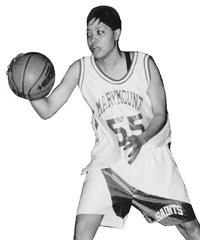NCAA News Archive - 2006
« back to 2006 | Back to NCAA News Archive Index
Marymount basketball standout typifies student-athlete resolve
|
The NCAA News
Corinne Carson knows that she’s an inspiration to other athletes, and she takes that responsibility seriously. As the first NCAA student-athlete known to return to her sport after a liver transplant,
Not only did she return to competition exactly one year to the hour after receiving a new liver, Carson excelled on the basketball court throughout that first season back in 1995-96 and the rest of her career at Marymount University (Virginia). She received Kodak all-American honors and was named the Division III Rawlings/WBCA national player of the year in 1997. She holds Marymount records for points per game, single-season scoring, single-game scoring, single-season free throws made, career blocks, single-season blocks and single-game blocks. She was the 1997 recipient of the Honda Inspiration Award.
In her first tournament after the transplant,
But most people didn’t know that after most games, she headed to the hospital for intravenous fluids to combat the severe dehydration that has become a part of her life since the transplant.
“You can drink all the water in the world, but you can’t hold it inside you,”
Many of her teammates knew what it took to get
“I was her favorite player, and I gave her inspiration because I was going through something as well. It was so good, but it was hard because you see somebody dying before your eyes,” she said. “She didn’t want to see anybody, and suddenly she’s reacting to me. It was scary, but I had to do it.”
For a 24-year-old woman who touched neither alcohol nor cigarettes, the results were unbelievable. She had the tests redone to the same end. When a third round of tests showed that not only was her liver damage severe, it was worsening quickly,
“Somebody tells you your liver is dying rapidly and they have no clue why — I was in denial,” she said. “I thought they were going to figure out what was wrong — it’s going to be something stupid, they’ll inject me with something and I’ll be all right.”
She didn’t have the symptoms often associated with liver disease — she had a healthy appetite and kept wishing they would let her out of the hospital so she could return to basketball. When Catholic-affiliated Marymount sent the president of the university over to pray for her,
“I’d never met the president, and I thought, ‘Why are they sending this guy in here to pray for me? Nothing’s wrong with me.’ I was really upset about it,” she said. “That night, they said I was delirious and tried to leave the hospital. It took eight doctors and nurses to hold me down. I don’t remember any of it.”
Doctors told her parents she was just hours from death. She received a new liver that night, spent two days in a coma and woke up in a hospital bed with tubes stuck in her.
“Next thing I know, I wake up strapped to a table and my mom’s saying, ‘You did it.’ I looked down and thought, ‘What are all these things on me?’
“It’s still like it’s a dream, like I’m going to wake up and it’s a long dream.”
Coach Finney remembers well his first trip to the hospital to see
“She had all the plugs and wires sticking out of her and the feeding tube ... you could hardly recognize her. I looked at her and she smiled, and the first thing she said was that it was great to see us,” he said. “Then she looked at me and said, ‘Coach, when I woke up, I felt the ball in my hand.’
“Then I knew she was going to come back to play.”
About six weeks later,
“She just looked at her and smiled and said, ‘I got a brand new liver,’ ” Finney said. “And that was it. They all broke.”
Less than a year later, Carson was back on the court with her team, slowly at first, but then working up to more playing time and leading her team to a successful season.
“She was a human highlight film. She was that good,” Finney said. “I’ve been coaching for 30 years, and she’s the best player, hands down, that I’ve ever coached, men or women. I’ve had some pretty decent players, but she was just a cut above.”
Finney’s wife nominated
“She became an inspiration to her teammates and coaches, her opponents, her fellow students, and also an extraordinary role model for young players — especially little girls,” Judy Finney wrote in the nomination. “She remained modest and unassuming throughout her medical ordeal, the regional and national basketball honors and the accompanying national press coverage. She often remarked that she didn’t think she was ‘special.’ But those who knew her and watched her were extremely grateful that she graced the basketball court and their lives.”
Today,
Since
Like many people who have come so close to dying,
“You’ve just got to do what you want to do and be happy doing that,” she said. “You can’t worry about tomorrow.”
1994 (Upsala)
Games 25
PPG 22.4
FG % 54.9
3-pt. % 44.3
FT % 71.0
Off. Reb/G. 4.7
Def. Reb/G 8.0
Total Reb/G 12.7
Asst/G 3.2
Blocks/G 3.8
Steals/G 3.3
1996 and ’97 (Marymount)
Games 60
PPG 20.2
FG % 53.5
3-pt. % 31.0
FT % 70.0
Off. Reb/G. 1.5
Def. Reb/G 6.1
Total Reb/G 7.6
Asst/G 4.0
Blocks/G 6.5
Steals/G 3.0
Coming in the February 13 issue of The NCAA News: A look at how the Association has developed into a staunch proponent of Title IX.
© 2010 The National Collegiate Athletic Association
Terms and Conditions | Privacy Policy

